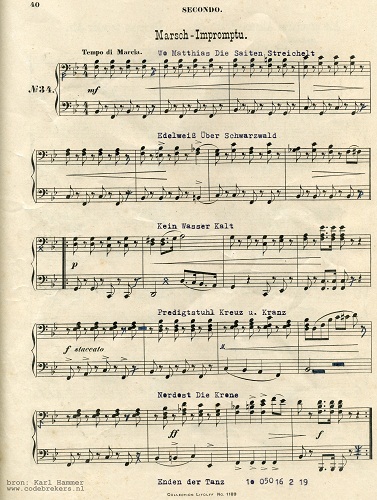Im oberbayerischen Mittenwald soll ein Schatz aus dem Dritten Reich versteckt sein. Die genaue Lage steht angeblich steganografisch kodiert auf einem Notenblatt. Das berichtet SPIEGEL Online.
Der Niederländer Leon Giesen ist sich sicher: Als sich gegen Ende des Zweiten Weltkriegs die Alliierten Mittenwald näherten, versteckten einige Nazi-Schergen wertvolle Gegenstände (z. B. Gold oder Diamanten), um sie nicht in die Hände des Feinds gelangen zu lassen. Kein Geringerer als Adolf Hitlers Privatsekretär Martin Bormann soll die genaue Position des Verstecks festgehalten haben – mit Hilfe von Wörtern, Zahlen und Runen, die er auf ein Notenblatt (“Marsch Impromptu”) schrieb. Ein Militärpfarrer sollte dieses Stück Papier nach München zu einem Parteifreund bringen. Heute befindet sich das Notenblatt (es besteht aus nur einer Seite) in Besitz des niederländischen Journalisten Karl Hammer. Weitere Details zu dieser Geschichte gibt es in einem gestern erschienenen Artikel bei SPIEGEL Online.
Das Dumme an der Sache: Bisher hat noch niemand den Geheimcode geknackt, den Bormann seinerzeit verwendet haben soll. Wer also meint, er könne das schaffen, sollte sich an die Arbeit machen. Ich bin sicher, es gibt Finderlohn, wenn der Schatz am Ende tatsächlich ausfindig gemacht wird. Details zum Notenblatt gibt es auf der Web-Seite von Karl Hammer – leider nur auf Niederländisch. Hier sind die drei wichtigsten Grafiken im Überblick:
- Das Notenblatt (wie oben gezeigt)
- Das Notenblatt mit Markierungen
- Die hinzugefügten Wörter, Zahlen und Runen ohne Noten
Ob an der Geschichte etwas dran ist, ist allerdings eine andere Frage. Verschlüsselte Nachrichten, die die Lage eines Schatzes verraten sollen, gibt es mehrere: Die Beale-Kryptogramme, das Kryptogramm von La Buse, das Kryptogramm von Rennes-le-Château, das Kryptogramm von Oak Island, das Jabron-Kryptogramm. Allerdings hat mit diesen Kryptogrammen bisher niemand auch nur die Spur eines Schatzes gefunden. Es würde mich wundern, wenn es dieses Mal anders wäre. Ich lasse mich aber gerne vom Gegenteil überzeugen.




Kommentare (26)